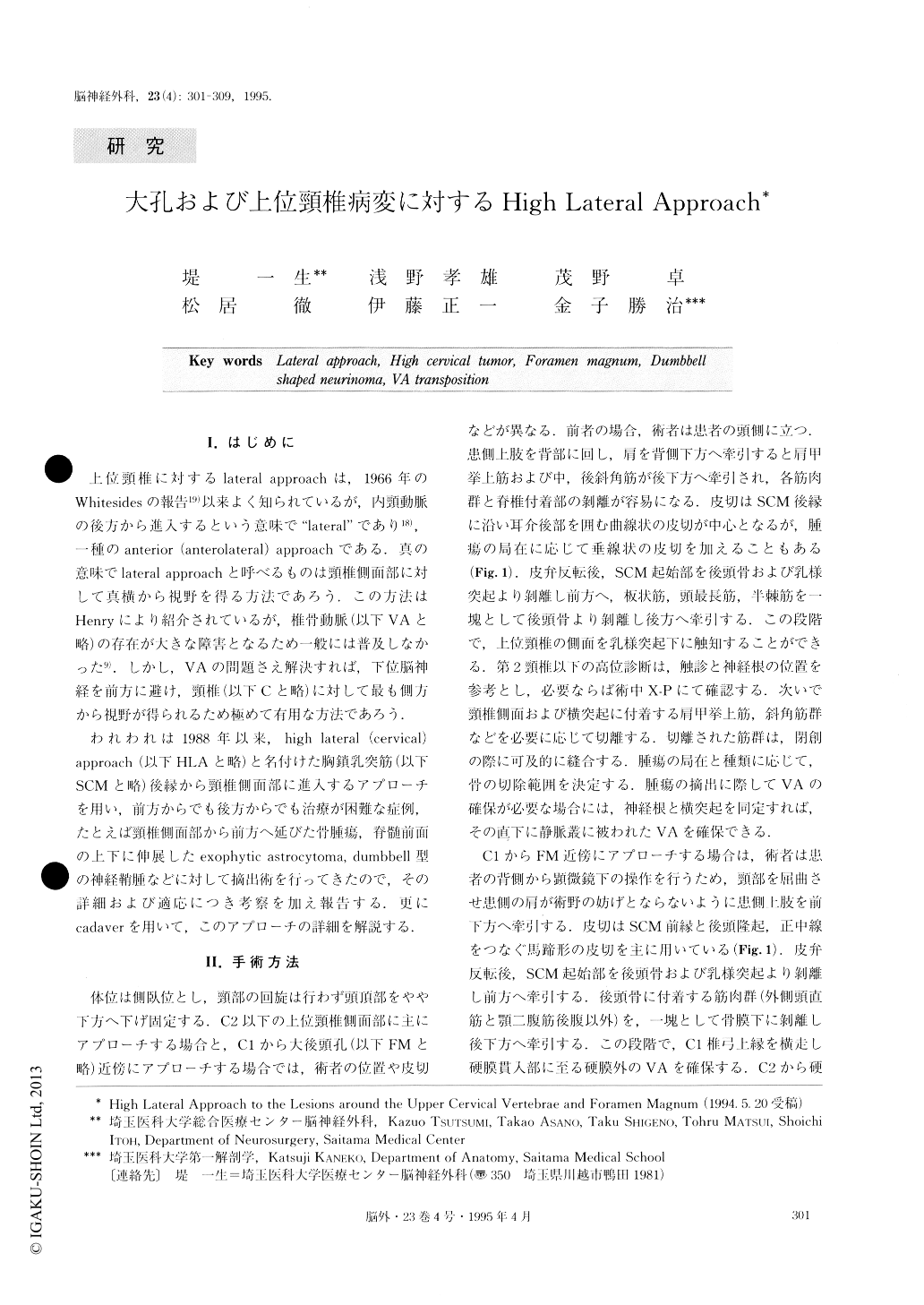Japanese
English
- 有料閲覧
- Abstract 文献概要
- 1ページ目 Look Inside
I.はじめに
上位頸椎に対するlateral approachは,1966年のWhitesidesの報告19)以来よく知られているが,内頸動脈の後方から進入するという意味で“lateral”であり18),一種のanterior(anterolateral)approachである.真の意味でlateral approachと呼べるものは頸椎側面部に対して真横から視野を得る方法であろう,この方法はHenryにより紹介されているが,椎骨動脈(以下VAと略)の存在が大きな障害となるため一般には普及しなかった9).しかし,VAの問題さえ解決すれば,下位脳神経を前方に避け,頸椎(以下Cと略)に対して最も側方から視野が得られるため極めて有用な方法であろう.
われわれは1988年以来,high lateral(cervical)approach(以下HLAと略)と名付けた胸鎖乳突筋(以下SCMと略)後縁から頸椎側面部に進入するアプローチを用い,前方からでも後方からでも治療が困難な症例,たとえば頸椎側面部から前方へ延びた骨腫瘍,脊髄前面の上下に伸展したexophytic astrocytoma,dumbbell型の神経鞘腫などに対して摘出術を行ってきたので,その詳細および適応につき考察を加え報告する.更にcadaverを用いて,このアプローチの詳細を解説する.
In the present paper, we describe the surgical tech-niques of high lateral cervical approach and its feasibil-ity for the excision of tumors located in the ventral or lateral aspect of the upper cervical vertebrae and of the craniovertebral junction.
The patient is positioned laterally on the operating table, but the operator's position and the skin incision are slightly altered depending on the location of the tumor. When the lesion is situated below Cl, the ipsi-lateral shoulder is pulled down toward the back. The operator stands rostral to the head. The attachment of the sternocleidomastoid muscle to the mastoid is de-tached and reflected anteriorly through a retroauricular curved skin incision. The posterior cervical muscles such as the splenius capitis, longissimus capitis, semi-spinalis capitis are detached from the occipit and re-tracted posteriorly. At this point, the transverse process of C1 and the articular facet of the vertebrae of C2 -C4 are identified by palpation. According to the tumor location, the muscles attached to the relevant transverse processes and facets are divided and reflected posterior-ly. Through careful dissection, the cervical nerve roots and the vertebral artery are exposed. The root sleeves as well as thecal sac may be exposed by resecting the posterior two-thirds of the superior and inferior articu-lar facets and the adjacent laminae of the vertebrae. In case the whole facet was removed, an iliac bone graft is placed between the remaining transverse processes and the laminae above and below for fixation.
On the other hand, when the lesion is around the foramen magnum or the jugular foramen, the operator stands at the back of the patient, so that the optical axis of the microscope can be directed rostally. For this purpose, the ipsilateral shoulder is pulled down toward the abdomen and an inverted “U” shaped skin incision is employed. The sternocleidomastoid muscle is reflected anteriorly and the attachments of all muscles to the ipsilateral occiput are detached and retracted posteroin-feriorly except for the digastric and the lateral rectus muscles. At this point, the vertebral artery (VA) sur-rounded by the venous plexus is identified along the groove of the atlas. Transposition of the VA is ex-tremely useful when a tumor situated anterior or medial to the VA is to be removed. This procedure involves unroofing of the C1 transverse foramen and division of the anterior ramus of the second cervical nerve. In case the tumor further extends into the posterior fossa, a re-tromastoid craniectomy combined with resection of the lateral rim of the foramen magnum and the posterior one-third of the occipital condyle is carried out. In order to obtain sufficient access to the ventral portion of the foramen magmun, the supero-medial portion of the occipital condyle is drilled away until the hypoglos-sal canal is opened, while the joint surface of the occi-pital condyle is preserved.
Until now, the above approach has been employed in nine patients who harbored various intra- and ex-tradural tumors in the high cervical area close to the craniovertebral junction. In every case, the excision of the tumor was total or almost total in a single opera-tion. Except for mild restriction of shoulder elevation in one case, no mortality or mobidity was encountered postoperatively. Through the above surgical experi-ences, the high lateral approach proved to have the fol-lowing advantages: 1) it affords a wide operative field in the lateral aspect of the upper cervical vertebrae; 2) the VA can be easily manipulated or transpositioned if necessary; 3) the lateral as well as the ventral portion of the upper cervical vertebrae and the anterior portion of the foramen magnum can be easily and safely approached without undue sacrifice of the lower cranial nerves or retraction of the neural axis; 4) combination with other approaches (infratemporal or transpetrosal approach) is easy.
In conclusion, this approach is considered to be feasi-ble for total resection of tumors located in the ventral or lateral aspect of the upper cervical vertebrae and foramen magnum. This has hitherto been difficult to achieve using the conventional approaches.

Copyright © 1995, Igaku-Shoin Ltd. All rights reserved.


